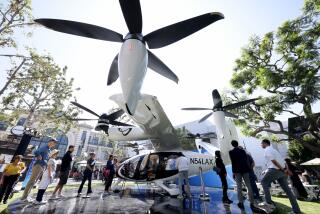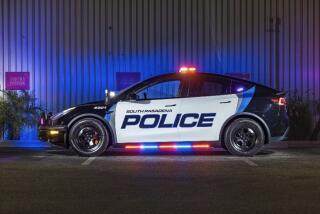Demand is Revving Up for Low-Speed Vehicles
The last time Nancy Woods needed to attend a business meeting, she didn’t take a car or use public transportation.
Instead, Woods, business manager of Santa Barbara’s Department of Parks and Recreation, strolled through her office parking lot to a shaded carport, unplugged a souped-up electric golf cart and hopped in.
She and three colleagues bounced along two city boulevards -- maxing out at about 25 mph -- to a Santa Barbara park, seat-belted into one of the 10,000 to 15,000 such contraptions that automakers say are in operation in California.
“It was convenient,” Woods said of the roughly mile-long trip. “And it was beautiful. The sun was out; the wind was blowing. We enjoyed it very much.”
Nearby at the city’s zoo, director Richard Block uses an electric cart to tote visitors up a hill.
“It’s nice, because it’s easy enough to use on pathways in the zoo, but I can take it out on short trips for business right around the zoo on the streets,” he said. “And it’s much more comfortable than a golf cart.”
No longer confined to the links or to planned communities like Leisure World, these low-speed vehicles, as the federal government calls them, are increasingly employed by civic organizations, businesses and others who want something cheaper and more environmentally friendly than cars.
“People are using them every day,” said Michael Coates of Green Car Marketing & Communications, a San Luis Obispo public relations firm. “They’re functional. They are a part of the transportation mix right now.”
A recent survey conducted by Coates’ company found 10,000 to 15,000 of the electric version of the vehicles in use in the state, although some counts have estimated the number to be lower. DaimlerChrysler, which makes a version, says it has 20,000 of them in service nationwide.
The average user takes 7.8 trips in one per day, the survey found; the vehicles travel an estimated 12.6 million miles per year and eliminate 8 million starts of combustion engines.
Their tiny niche has been jump-started in large part by huge corporate donations of the vehicles. Ford gave 500 to municipalities and parks in California just last year. DaimlerChrysler has donated vehicles here and in several other states, and has begun a generous rebate program in New York, Vermont and Massachusetts.
Ironically, however, these funny little vehicles are actually getting harder to find just as their owners are starting to enjoy them: Ford, which made an electric version called the Think Neighbor, has shut down production, and DaimlerChrysler has cut way back on its Global Electric Motorcars (GEM) subsidiary.
Manny Salierno, who sells GEMs in the Long Island community of Bethpage, N.Y., said he has moved 200 of them in the last three months. Purchasers include the owner of a day camp who ordered 33 vehicles, older people who use them to tool around retirement communities and younger adults who buy them for short hops around town. Salierno, who advertises the vehicles on EBay as well as in newspapers, said he gets 10 to 20 inquiries a day.
Salierno said he had to turn away some customers after DaimlerChrysler ran out of the four-seat version equipped to meet New York regulatory standards.
The cutbacks were partly market-driven. Ford spokesman Miles Johnson said consumers just weren’t ready for the bubble-like electric vehicles, which look like golf carts but sport seat belts, turn signals and wide, high windshields. More to the point, perhaps, the price at which consumers expressed interest in the vehicles was about $3,000, said Salierno and others, less than half of the automakers’ suggested retail price.
But there was a political component as well: The automakers had received credit toward meeting air pollution regulations by selling or donating the cars in California and elsewhere. But now implementation of some of those regulations has been put off in the Golden State, making the need to establish a market here less pressing.
Similar regulations have been approved in other states -- hence DaimlerChrysler’s recent donations and rebates on purchases in New York and parts of New England. But now that the company has essentially met environmental requirements and placed a critical mass of vehicles in service, officials have decided to cut back and wait for demand to build, said spokesman Sam Locricchio. This year, DaimlerChrysler cut its work force at the GEM plant in Fargo, N.D., to 85 workers from a high of 185, he said.
Salierno said some of his customers, unable to find the DaimlerChrysler vehicle and unwilling to wait for next year’s model, were planning to buy used ones.
“We really didn’t feel it made sense to be in a business where the demand just wasn’t there yet,” said Johnson of Ford. “It’s great technology ... but there isn’t a consumer marketplace out there.”
Tell that to Tony Natale, who uses gas-powered versions of the carts in his auto detailing business, scooting up and down streets in Long Beach’s Belmont Shore and Naples communities. Natale settled on old-fashioned, gas-burning golf carts with improved engines, because the electric vehicles were hard to find when he was building his business in the late 1990s.
“I wound up getting one because of the parking problem in the Belmont Shore and Naples area,” he said. “I had my truck and all my equipment, and I found myself having to park a block away and carry everything we were using for the detailing. Now I only need three feet of room -- I can back in and park between two cars.”
Natale estimates that his brightly painted carts, which also serve as free advertising as they putt through the neighborhood, get 300 miles to a six-gallon tank of gas. By comparison, he said, his Dodge Dakota gets about 8 1/2 miles to the gallon.
The vehicles are legal in 22 states, to be driven only on streets with a speed limit of 35 mph or less. The consumer versions, like Natale’s, have two or four seats, shoulder belts, turn signals, windshield wipers and halogen headlights. They’re about as tall as a minivan, and some come with a choice of hard or soft doors. The electric ones, which account for most of those in service, can be plugged into a regular 110-volt outlet to be recharged.
In Santa Barbara, the little Fords are so popular among city workers that officials wanted to buy more: a few for the Public Works Department, and another for the zoo.
There was just that problem of Ford quitting production.
“They stopped making them, so that kind of cramped our style,” said zoo director Block. “Just as things really started to catch on, they dropped out of it.”
If you have a question, gripe or story idea about driving in Southern California, write to Behind the Wheel c/o Los Angeles Times, 202 W. 1st St., Los Angeles, CA 90012, or send an e-mail to [email protected].
More to Read
Sign up for Essential California
The most important California stories and recommendations in your inbox every morning.
You may occasionally receive promotional content from the Los Angeles Times.










